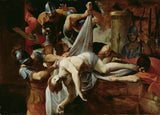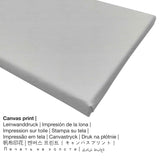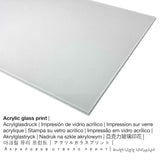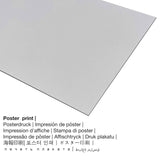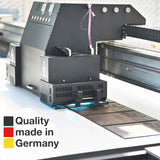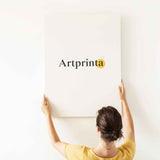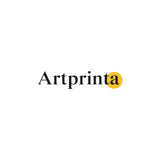Ludovico Carracci, 1612 - St. Sebastian tụbara n'ime Cloaca Maxima - ọmarịcha akwụkwọ nka.
Ụtụ gụnyere. Mbupu gbakọrọ na ndenye ọpụpụ.
Ozi izugbe sitere na webụsaịtị ihe ngosi nka (© - nke J. Paul Getty Museum dere - Ụlọ ihe ngosi nka nke J. Paul Getty)
Although Saint Sebastian is usually depicted bound to a tree or pillar and pierced by arrows, that attempt by the Romans to take his life was unsuccessful. Ludovico Carracci chose to represent the moment after the subsequent deadly beating, when Roman soldiers dumped Sebastian's limp and lifeless body into a sewer.
Against the dark of night, brutish soldiers lift and tug the dead saint's body. Ludovico contrasted the tensile strength of their straining bodies with the slackness of the saint's limbs, head, and facial muscles as he falls into the sewer's depths. The night atmosphere is dark and thick: figures seem to emerge from the blackness. Light glints dully off helmets and armor, but the soldiers' faces are unreadable. A bright light suffuses the body of Saint Sebastian, making him the focal point of the composition.
In 1612 Cardinal Maffeo Barberini commissioned this painting from Ludovico for his family's chapel in the Church of San Andrea della Valle in Rome. The chapel commemorated the site where Saint Sebastian's body was recovered from the sewer, called the Cloaca Maxima. Barberini decided to keep the painting in his private collection, believing that an image of the recovery of Sebastian's body by Christians was more appropriate for the church.
a 17th narị afọ masterpiece was painted by the painter Ludovico Carracci in 1612. Today, this artwork can be viewed in in the The J. Paul Getty Museum's art collection. With courtesy of: The J. Paul Getty Museum (ikikere: ngalaba ọha).Furthermore, the work of art has the creditline: . Besides this, the alignment of the digital reproduction is in landscape format ma nwee oke onyonyo nke 1.4: 1, nke pụtara na ogologo bụ 40% ogologo karịa obosara.
Họrọ ihe ngwaahịa gị
The product dropdown menu provides you with the possibility to choose a material and a size of your choice. The following options are available for individualization:
- Mbipụta aluminom (aluminium dibbond): Aluminium Dibond prints are metal prints with a true depth effect, which creates a contemporary impression by having a surface structure, which is non-reflective. A direct Direct Print on Aluminum Dibond is the ideal introduction to the sophisticated world of fine art prints made with aluminum. For the Print On Aluminum Dibond, we print your chosen artwork onto the surface of the aluminum. The colors are luminous in the highest definition, details of the print are crisp and clear, and you can literally feel the matte appearance of the fine art print.
- Akwụkwọ mmado na ihe kwaaji: Our poster is a printed cotton canvas paper with a slightly roughened surface finish. Please bear in mind, that depending on the size of the poster we add a white margin of approximately 2-6cm round about the print motif to facilitate the framing with a custom frame.
- Mbipụta enyo acrylic: A glossy acrylic glass print, often denoted as a plexiglass print, makes the original into magnificient home decoration and offers a distinct alternative to dibond and canvas fine art prints. Our acrylic glass protects your chosen fine art print against light and heat for between four and 6 decades.
- Mbipụta kwaaji: The UV printed canvas applied on a wooden stretcher frame. A canvas has a special effect of three dimensionality. The advantage of canvas prints is that they are relatively low in weight. That means, it is easy and straightforward to hang the Canvas print without the use of extra wall-mounts. Hence, a canvas print is suited for all kinds of walls.
Ihe omuma ihe nka
| Ihe nkiri: | Ludovico Carracci |
| okike onye nka: | nwoke |
| Obodo onye nka: | Italian |
| Ọrụ onye na-ese ihe: | onye na-ese ihe |
| Obodo onye nka: | Italy |
| Nhazi nke onye nka: | nna ukwu ochie |
| Ndụ: | 64 afọ |
| Afọ ọmụmụ: | 1555 |
| Nwụrụ n'afọ: | 1619 |
Nkọwa na ihe osise pụrụ iche
| Iberibe aha nka: | "St. Sebastian Thrown into the Cloaca Maxima" |
| Nhazi nka nka: | sere |
| Category: | nka ochie |
| Nhazi oge: | 17th narị afọ |
| Emepụtara n'afọ: | 1612 |
| Afọ nka: | ihe dị ka afọ 400 |
| Egosiputara na: | Ụlọ ihe ngosi nka nke J. Paul Getty |
| Ebe ngosi nka: | Los Angeles, California, Njikota Obodo Amerika |
| Weebụsaịtị ihe ngosi nka: | Ụlọ ihe ngosi nka nke J. Paul Getty |
| License: | ngalaba ọha |
| Site n'aka: | Ụlọ ihe ngosi nka nke J. Paul Getty |
Banyere akụkọ
| Bipụta ngwaahịa: | ọmarịcha nka |
| Usoro mmeputakwa: | dijitalụ mmeputakwa |
| Usoro mmepụta: | Mbipụta UV / dijitalụ |
| Ihe ngosi: | emere na Germany |
| Stockdị ngwaahịa: | a na-achọ |
| Ojiji ngwaahịa: | Ụlọ ihe osise nka, foto mgbidi |
| Ndozi onyonyo: | usoro odida obodo |
| Ụdị anya: | 1.4: 1 |
| Akụkụ onyonyo pụtara: | ogologo bụ 40% ogologo karịa obosara |
| Ụdị dị iche iche dị: | Mbipụta kwaaji, mbipụta enyo acrylic (nwere ezigbo mkpuchi iko), mbipụta ọla (aluminium dibond), mbipụta akwụkwọ mmado (akwụkwọ kwaaji) |
| Mbipụta kanvas (akwa akwa na etiti ihe ndọtị) dị iche iche: | 70x50cm - 28x20", 140x100cm - 55x39" |
| Mbipụta iko acrylic (nwere ezigbo mkpuchi iko) nhọrọ nha: | 70x50cm - 28x20", 140x100cm - 55x39" |
| Ụdị akwụkwọ mmado (akwụkwọ kwaaji) dị iche iche: | 70x50cm - 28x20" |
| Mpempe akwụkwọ Dibony (ihe alumnium) nha: | 70x50cm - 28x20", 140x100cm - 55x39" |
| Nhazi mbipụta nka: | adịghị |
Important information: We try all that we can to describe our products as closely as it is possible and to display them visually on the respective product detail pages. Although, the tone of the print materials and the imprint can diverge somehwat from the representation on your screen. Depending on the screen settings and the condition of the surface, not all colors will be printed as exactly as the digital version on this website. Since the are printed and processed by hand, there may also be minor deviations in the motif's exact position and the size.
© Nchekwa ikike nwebisiinka, Artprinta (www.artprinta.com)

